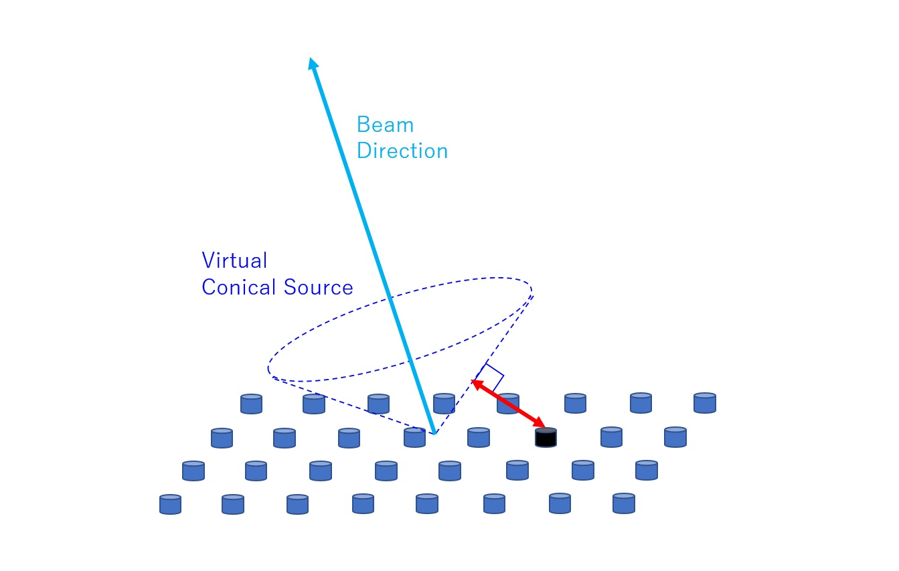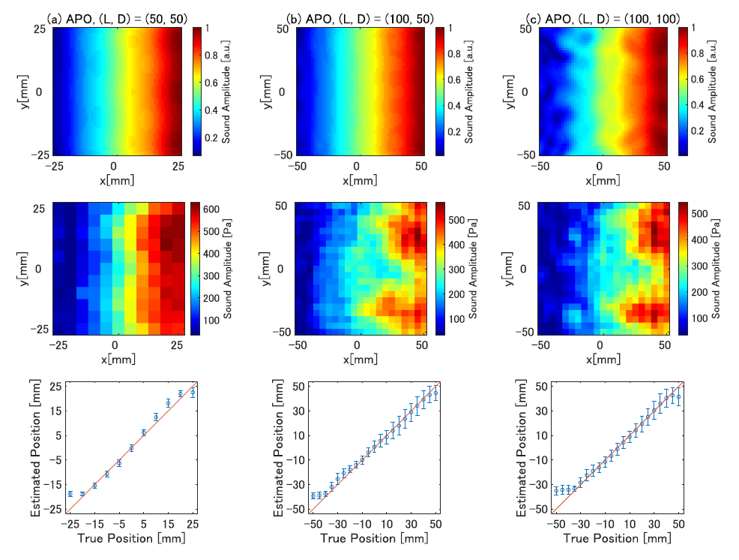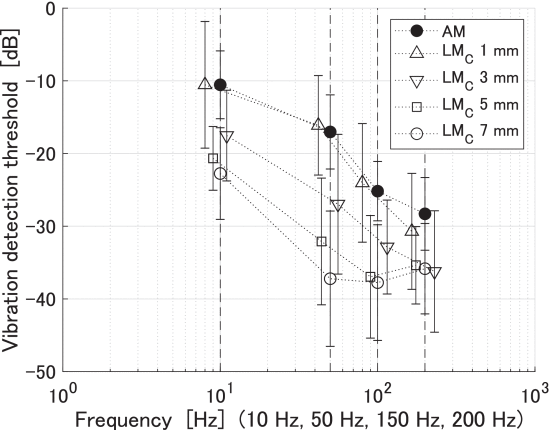Overall Introduction
We study construction of wavefield-based computed physical systems. Currently we mainly focus on ultrasound field to realize those systems.
The air, the medium that fills almost all spaces around us, has not been widely considered as an engineering research topic in terms of remote control and measurement.
However, it does not indicate that such studies are not practically important. For example, minutely controlled flow field in the air will be utilized in novel applications such as airborne fragrance transportation to specific person, indoor heat distribution control for improving the efficiency of room-embedded air conditioning systems, and so forth.
Holographic ultrasound fields that have specifically designed spatiotemporal acoustic power distributions, can be utilized for self-positioning of devices and a new form of wireless communication systems.
We address the designing problem of ggoodh wavefield that can achieve the abovementioned functions by efficiently causing associated physical phenomena such as realization of holographic pressure distribution or sound-medium interactions.
Technically, the paradigm of the inverse problem theory, which incorporates optimization techniques with physical models that describes the causality of the system, is quite powerful to tackle those problems.
We utilize ultrasound phased array, which is a set of multiple sinusoidal wave sources whose output amplitude and phase delays can be individually controlled.
We also study sensory information displays for human users. We have our particular interest in haptics systems.
Remote Airflow Field Control by Ultrasound-Driven Force Field
When sound travels in the air, it accompanies airflows caused by acoustic power propagation. This effect is known as gacoustic streamingh, which is one of representative nonlinear acoustic phenomena. We do not perceive acoustic streaming in our daily lives because this effect is valid only when the sound field is sufficiently strong. Physical theories indicate that a lump of air is accelerated by the ultrasound-driven force whose magnitude is proportional to the acoustic power that passes through the lump. Therefore, the acoustic streaming is understood as the consequence of localized air acceleration by spatially uneven acoustic power distribution.
We have demonstrated that narrow and isolated steerable airflows can be generated by forming midair straight beams (Bessel beams) or curved beams.
In addition, we experimentally demonstrated that such airflows can transport fragrance emitted from an object to a specific person in the environment.
Conventional methods such as jets and fans are unable to generate such narrow airflows apart from the devices. The physical characteristics of waves contributes to formation of narrow airflows, that can be spatially converged in regions far from the wave sources.
We think our current application scenarios are limited in comparison with the degrees of freedom in acoustic field designing. So we are working on a extended variation of the ultrasound-driven flow field systems.


Acoustic Bessel Beam (Left) and Water Vapor Guided along the Acoustic Streaming (Right)
Related Articles:
Keisuke Hasegawa*, Hiroki Yuki*, Hiroyuki Shinoda; "Curved Acceleration Path of Ultrasound-Driven Air Flow," Journal of Applied Physics, 125, 054902, 2019.
https://doi.org/10.1063/1.5052423 (* denotes equal contribution).
Keisuke Hasegawa, Liwei Qiu, Hiroyuki Shinoda, “Midair Ultrasound Fragrance Rendering,” IEEE Transactions on Visualization and Computer Graphics, vol. 24, no. 4, pp. 1477-1485, April 2018.
http://doi.org/10.1109/TVCG.2018.2794118.
Keisuke Hasegawa, Liwei Qiu, Akihito Noda, Seki Inoue, Hiroyuki Shinoda, “Electronically Steerable Ultrasound-Driven Long Narrow Air Stream”, Applied Physics Letters,
111, 064104, 2017.
http://doi.org/10.1063/1.4985159,(Highlighted as APL Editor’s Picks for the week of August 20, 2017.)
Information Field Embedded in the Environment by Structured Acoustic Field
The phased array can create a specific spatiotemporal pattern of acoustic power in the air.
On the basis of this principle, a situation can be realized where acoustic sensors receive position-dependent signals. When the received signal is correlated with the observation position, a device with a single microphone can achieve indoor self-positioning. We created a one-directional gradient field of acoustic amplitude, which resulted in midair self-positioning with accuracy of several millimeters.
We also proposed a method of three-dimensional positioning based on the angular scanning of Bessel beams.
Such information wave fields can also be utilized for other application, such as realization of exhibition site with rewritable position-dependent introductory information to visitors.


Self-positioning by 1D-gradient amplitude field (Left)
Positioning based on angular scanning of Bessel beams (Right)
Related Articles:
Keisuke Hasegawa, Hiroyuki Shinoda, Takaaki Nara, "Volumetric Acoustic Holography and its Application to Self-Positioning by Single Channel Measurement," Journal of Applied Physics, vol. 27, no. 4, 244904, 2020.
DOI:10.1063/5.0007706.
Keisuke Hasegawa, "Indoor Self Localization of a Single Microphone based on Asynchronous Scanning of Modulated Bessel Beams," in Proc. SICE Annual Conference 2019, pp. 142-147, Sep. 10-13, 2019, Hiroshima, Japan.
Haptic Display Systems
We possess the haptic sense all over our bodies. But much remains unrevealed in its mechanism and thus many potential applications also remain unrealized.
Our recent study has revealed that we can recognize alphabet lower case letters by forced hand movement driven by external force, where our hand holds an electronically manipulated stylus that traces the letter trajectories. In our experiment, letters with normal writing speeds and sizes could be accurately ereadf.
In addition, we have constructed several midair haptics systems by focused airborne ultrasound that locally vibrates skin surface to cause vibrotactile sensation. We found that the repetitive horizontal movement of the focus (we call this the lateral modulation method: the LM method) could offer stronger vibrotactile stimuli compared with the conventional time-variant amplitude modulation (AM method) of the still focus. This result suggests the possibility of whole-body midair haptics system that could not be achieved by the conventional AM method that can only offer perceivable stimuli on glabrous skin.


Haptic reading system with forced writing (Left)@
Lowered detection threshold of vibrotactile stimuli by the LM method (Right)
Related Articles:
Ryoko Takahashi, Keisuke Hasegawa, Hiroyuki Shinoda, "Tactile Stimulation by Repetitive Lateral Movement of Midair Ultrasound Focus," IEEE Transactions on Haptics, vol. 13, no. 4, pp. 334-342, 2020. DOI:10.1109/TOH.2019.2946136.
Keisuke Hasegawa, Tatsuma Sakurai, Yasutoshi Makino, Hiroyuki Shinoda, “Character Reading via Stylus Reproducing Normal Handwriting Motion”, IEEE Transactions on Haptics, vol.9, no. 1, pp. 13-19, Jan.-March 2016. doi:10.1109/TOH.2016.2517625





